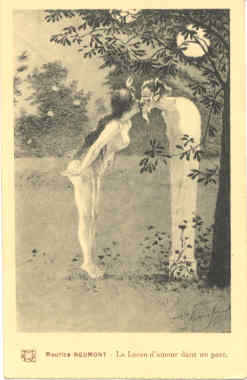|
Krampus Every comic book hero worth his salt has an archenemy. Batman has the Joker, James Bond has Dr. No, Luke Skywalker has Darth Vader, and Santa Claus has Krampus.
Every comic book hero worth his salt has an archenemy. Batman has the Joker, James Bond has Dr. No, Luke Skywalker has Darth Vader, and Santa Claus has Krampus. Wait a minute, Santa has an archenemy? Krampus is one of those quirky survivals of a pagan tradition that preceded Christianity. Much like Santa himself. Or Jesus. Oops, did I say Jesus? Never mind. Santa Claus is a Christianization of a handful of traditional winter solstice figures, who morphed into St. Nicholas after the Catholics swarmed into Austria. Santa was most heavily influenced by the Norse Thor, who had a long white beard and cheerfully rode a flying chariot. The enemy of good in Norse mythology was Loki, a figure usually depicted as falling somewhere in the range between Satan himself and Carrot Top. Loki was a devil-trickster figure with big horns. (Of course, most Norse gods were wearing horns on their hats if they didn't have them growing out of their heads.) While the noble Thor was a good candidate for transformation into a Christian saint, Loki was not so much. But old gods never die, they just fade away. The lingering afterimage of Loki became part of the template for Krampus. The tradition is primarily an Austrian thing, although it spread erratically around Europe. There are two takes on Krampus, one being a secular humanist approach and the other being a magic tradition angle. If you put any two Austrians in a room, they'll soon get into an fistfight about which interpretation is correct. In the secular humanist approach, Krampus and the observation of Krampus traditions are pretty much just the antithesis of Santa Claus. On Dec. 5, the eve of the feast day of St. Nick, Austrians celebrate Krampus by running across the city in grotesque masks and generally scaring children. This is an extension of the good-cop, bad-cop theory. St. Nick makes his rounds on Dec. 6 rewarding all the good little children, a task which is made easy since Krampus has been out the night before, punishing pretty much the same children with a good switching.
Then, all the adults go out and gets drunk, and much hilarity ensues. The other interpretation of Krampus is more mystical. Under this theory, people dress up in the hideous masks of Krampus in order to scare off evil spirits. If so, this is in keeping with a pretty universal traditional use of masks in religious ritual; the concept of a fearsome visage that wards off cowardly evil spirits has a lot of pedigree, and not just in the snowy mountains of Germanic Europe where people get a little unbalanced in the winter (remember Krystallnacht?). In Hindu mythology, Black Makhala fills the Krampus role, while the Japanese wore masks that were supposed to be lions, but frankly look more like Benji. The Krampus masks benefit from being particularly grotesque, or to be more accurate, stupid-looking. Let's just say Hindus have a better aesthetic sense than Austrians. Krampus masks suffer from the silliness of the whole Christian devil image, but occasionally he's presented as passably scary looking. Especially if you're eight years old. Oh, did I forget to mention the fucking? One of the relative benefits of paganism over Christianity is that paganism usually has holidays devoted to wild orgiastic excess. The Celts indulged in this behavior around Easter, which led to the adoption of the Easter bunny as mascot for the Christian version. Austrians liked to keep warm during those cold winter months, if you catch my drift.
A cottage industry in Austria from Victorian times through the present has been the production of Krampus postcards to commemorate the holiday season. These tend to feature Krampus and his prodigious tongue assailing various Betti Page-type pinup girls (or even pure-hearted Austrian housefraus) with his lecherous advances. During World War II, Krampus shamefully pandered to the Nazis in such postcards, doing a series of propaganda appearances in which he trounced and embarrassed British and French citizens and soldiers. After WWII, it was rumored that Krampus fled to Brazil and took part in an evil cloning scheme, but our team of investigators has failed to confirm those reports.
|
 In other variations on the theme (and there a lot of variations considering what a relatively small geographical area we're talking about here), Krampus is one of Santa's minions, who follows along obediently passing out presents or switches depending on the moral turpitude of the child in question. Presumably, this would make the pointy-eared Krampus kind of the template for Santa's elves in later Rankin-Bass productions, but the jury is still out among the scholarly community on this subject.
In other variations on the theme (and there a lot of variations considering what a relatively small geographical area we're talking about here), Krampus is one of Santa's minions, who follows along obediently passing out presents or switches depending on the moral turpitude of the child in question. Presumably, this would make the pointy-eared Krampus kind of the template for Santa's elves in later Rankin-Bass productions, but the jury is still out among the scholarly community on this subject. 